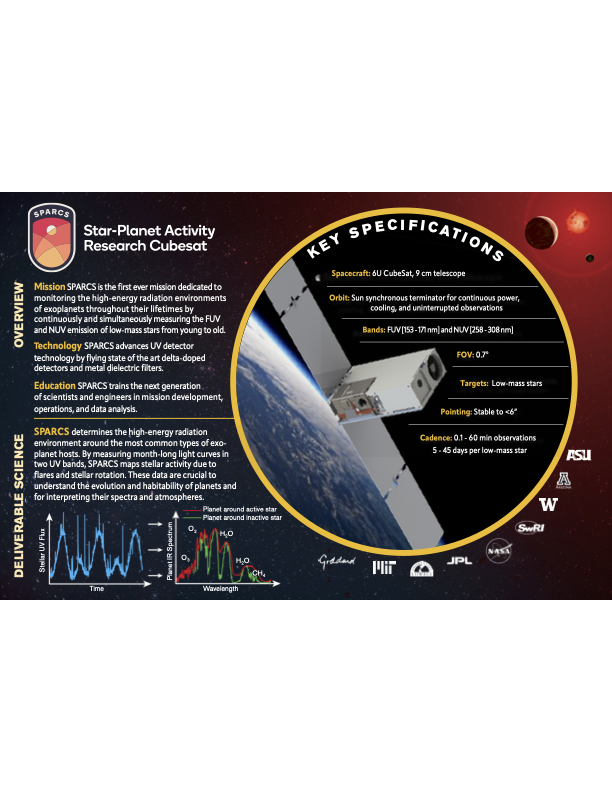
About SPARCS
The Star-Planet Activity Research CubeSat (SPARCS) is a small space telescope about the size and shape of a family-size cereal box. It is built of six cubical units, each about four inches on a side. These are joined to make a spacecraft two units wide by three long in what is termed a 6U spacecraft; solar power panels extend like wings from one end.
The mission which SPARCS will undertake is monitoring the flares and sunspot activity of low-mass stars of K and M spectral type in the far- and near-ultraviolet to assess how habitable the space environment is for planets orbiting them.
The stars that SPARCS will focus on are small, dim, and cool by comparison to the Sun. They have less than half the Sun's size and temperature, and they shine with barely one percent its brightness.
These stars are the most numerous in our Milky Way Galaxy and host most of the exoplanets, including the vast majority of the Habitable Zone terrestrial planets in the galaxy, roughly 50 billion! This zone is the potentially life-friendly region close to the star where temperatures are neither too hot nor too cold for life as we know it, and liquid water could exist on a planet's surface.
Science & Technology
The spacecraft will contain four major systems — the telescope, the camera, the spacecraft, and the operational and science software. ASU astronomers, lead by mission Principal Investigator and astrophysics profession, Dr. Evgenya Shkolnik, will oversee the development of the telescope and camera, plus the software and the systems engineering. The telescope uses a mirror system with coatings optimized for ultraviolet light. Together with the camera, the system can measure very small changes in the brightness of low-mass K and M stars to carry out the primary science of the mission. The instrument is now being tested and calibrated at ASU in preparation for flight before being integrated into the rest of the spacecraft.
For each target star, SPARCS will observe continuously over at least one complete stellar rotation (5 to 45 days). SPARCS will also advance ultraviolet detector technology by flying high quantum efficiency, UV-optimized detectors developed at NASA's Jet Propulsion Laboratory, led by Dr. Shouleh Nikzad. These delta-doped detectors have a long history of deployment demonstrating greater than five times the quantum efficiency of the detectors used by the Galaxy Evolution Explorer (GALEX) mission.
SPARCS will pave the way for their application in future UV missions like NASA's next UV-capable flagship mission, the Habitable Worlds Observatory, including smaller interim missions. SPARCS will also be capable of "target-of-opportunity" ultraviolet observations for the rocky planets in low-mass star habitable zones. This will provide the needed ultraviolet context for the first habitable planets that the James Webb Space Telescope is characterizing.
